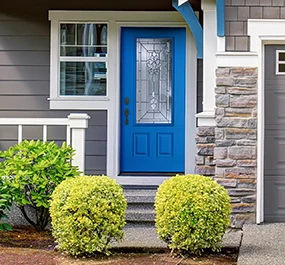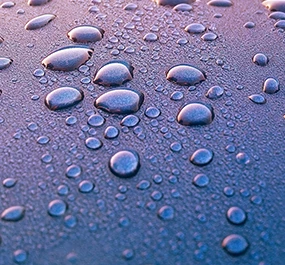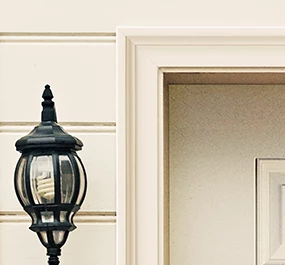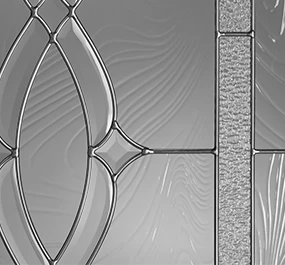The arrival of winter is a transition point in seasons and indoor living. Homeowners spend more time indoors during the fall and winter seasons, attempting to escape the often harsh segue from the crisp fall air to the wrath of winter.
If you haven’t winterized your home in time for the seasonal transition, be proactive and you’ll enjoy a lovely winter-proof house that stays warm all season long without busting your budget.
In this blog, we’re helping homeowners like you learn how to winterize your house and front entry door, so you can maintain a cozy living space through the holidays and into the spring.
Key Steps to Winterize Your Home
Your home’s exterior and front entryway are subjected to the brutalities of the winter season. Harsh winds, snow, ice, and other threats loom all season long. If you haven’t sealed all the exposed gaps in your home, seize the opportunity to do so now before the cold temperatures arrive. Outdated or non-existent home insulation must also be addressed. Enhance the insulation, clean the roof, unclog the gutters, and inspect the remainder of your home in anticipation of the shift to winter.
Basic gutter maintenance and subtleties such as weatherstripping might not seem like much as individual home improvement projects before the start of winter yet they add to a whole greater than the sum of their parts.
Plastpro’s high-quality doors are designed to conserve energy and hold strong throughout the winter. Our weather-ready doors are the missing piece to your home's winter-proofing puzzle. Remember, your front door serves as the primary defense between your home and the exterior elements, so its importance can’t be understated.
Plastpro’s Winter-Ready Doors: A Game Changer
An unreliable, weathered, or otherwise aged front door has the potential to be your home’s Achilles heel this winter. You’ll enjoy invaluable peace of mind after replacing your outdated door with a Plastpro winter-ready door.
Our front doors are designed with longevity in mind. We build strong, reliable, winter-ready doors that hold strong for years. Our doors are energy efficient, trapping the air of your preferred temperature inside your home while keeping outdoor air where it belongs - outside. The result is a formidable barrier to weather resistance and a reduction in your monthly energy bill.
Our fiberglass doors excel in energy efficiency, thanks to their distinctive high-density Polyurethane foam core insulation. Effective insulation is key to cutting energy use, managing building expenses, and keeping your home insulated by effectively blocking external elements. As a result, our ENERGY STAR Certified Doors not only result in reduced electricity consumption and decreased utility bills for homeowners but also enhance comfort and contribute to environmental conservation.
Beyond your front door, here are a few other steps to check off your home winterization checklist.
Weatherstripping and Insulation
Retaining warmth throughout your home from the start of fall to the beginning of spring is challenging yet possible, especially if you are willing to objectively analyze your home’s weak points. Inspect your house’s roof, gutters, windows, doors, and other potential points of entry. Chances are you will notice cracks, gaps, missing shingles, clogs, and other issues. Address those problems today and you’ll transition to the winter season in full confidence.
Add weatherstripping and insulation to windows, doors, and walls. If you spot even a slight crack or gap around the edge of a door or window, proactively eliminate it right away with a sealing. Weatherstrip the perimeter of your door and you’ll prevent drafts from seeping through the gap between the door and the frame. Such slight home winterization enhancements might not seem significant yet they have the cumulative potential to save you a significant amount of money on home utilities.
When insulating your home, be especially mindful of the attic. Extra insulation should be added throughout this uppermost part of the home to prevent the formation of ice dams. The alternative is to run the risk of excessive heat moving upward into the attic where it warms the roof.
Warming the roof is problematic in the winter as it is likely to be covered in snow and ice for at least half the season if not longer. If refreezing occurs thereafter, an ice dam will likely form that has the potential to build up to the point that it eventually leaks water down below, causing water damage to your home. The worst-case scenario is the formation of an ice dam on the roof that results in a partial or total roof collapse.
Roof and Gutter Maintenance
Most homeowners aren’t exactly enthusiastic about the idea of getting up on a ladder to clean out the gutters, inspect the roof, and eliminate piles of leaves and other debris. However, ignoring such problems will lead to clogs, buildup, excess weight, and leaks. A well-maintained roof is essential for preventing such damage.
If you are afraid of heights or simply do not want to risk climbing a ladder, lean on a professional to check and repair your roof and gutters. At a bare minimum, the gutters should be cleaned and checked for stability at least once each year. Neglect your gutters and the chances of an ice dam that necessitates a costly clearing and repair will increase all the more. Add gutter guards for an additional line of protection and you’ll minimize the potential for blockages.
Plumbing Precautions
Can you imagine a pipe bursting in the middle of a cold winter night, drenching your home and belongings in bone-chilling water that has the potential to freeze? This nightmare scenario occurs in homes every single year. You can do your part to minimize the potential for frozen pipes this winter by insulating all piping that is exposed.
Drain the hoses and faucets that are outdoors. If you don’t know where your home’s outdoor faucet water valves are in your basement, your local plumber will help you find them. Such valves are typically positioned along pipes that run along basement ceilings and walls.
Turn off the flow of water to outdoor faucets at the start of the winter and you’ll reduce the chances of a pipe breaking and potentially flooding your basement. The last thing you want is a flooded basement in the middle of a brutally cold winter. Don’t forget to bring in the hose(s) connected to the outdoor faucet(s). Drain the outdoor hoses and store them in the basement.
If your home has piping exposed in parts of the home that are unheated, be it the attic, a crawl space, or a garage, wrap it in heat tape that is UL-listed. Thermostatically-controlled tape can be used for plastic piping.
The thermostat must be at a reasonable temperature to keep the “guts” of its plumbing and other components safe and functional. It will also help to let your faucets drip on the coldest nights of the winter when there is the potential for pipes to freeze and burst.
If you take a vacation or are away from your home for an extended period in the winter, be sure to keep the heat on. Allow the furnace to run during this period, guaranteeing the home is warmed to a suitable temperature to prevent pipes from freezing. At a bare minimum, the furnace should be set to a level of 55 degrees Fahrenheit when away from the home for more than a couple of days. This level of heat keeps pipes, home woodwork, floors, and wall cavities above the temperature at which freezing and warping occur.
Chimney and Fireplace Care
If your home has a fireplace and chimney, be cognizant of their inherent risks. All fireplaces have the potential to malfunction if the chimney airway is clogged. Spend for a chimney inspection and cleaning at least once every two years. Add a high-quality glass fireplace door or fireplace screen for additional safety.
Heating Systems Check
When was the last time you had your home furnace cleaned and maintained? Ideally, such an analysis will be performed once each year, preferably before the start of winter. Be sure to replace the cooling system’s filter once each month. If your home has an outdated thermostat, replace it with one of the programmable varieties to maximize energy efficiency.
Outdoor Maintenance and Landscaping
Remember to protect your landscaping before the start of winter. You can safeguard your home’s exterior landscaping with burlap. This material is optimal for landscaping greenery such as plants and bushes, keeping them undercover to prevent exposure to harsh wind, snow, ice, and other winter threats.
Ensure a Warm and Safe Winter with Plastpro
The upcoming winter is guaranteed to be a challenge, yet the right prep work and quality products will help you maximize your home’s energy efficiency and your comfort. In short, you have the power to make this winter warm and safe.
Weave in the strategies detailed above and you’ll find your home stays warm throughout the winter. Take action to winterize your home today by replacing your old door with a Plastpro door. Plastpro is revered as one of the world’s leading wholesale door manufacturers. Our primary product line is highlighted by fiberglass doors, with our inventory also extending to specialized doors such as those of the trimmable variety, doors that are ADA compliant, and storm doors.
You can buy Plastpro products from a local distributor. Check out our Where to Buy page to find a Plastpro distributor in or near your zip code.



